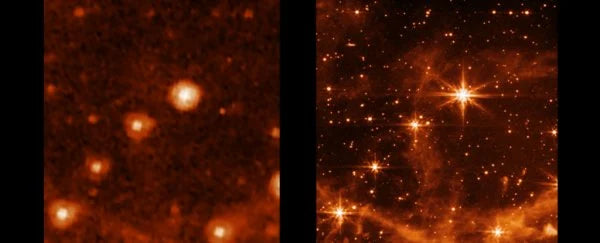
Pants-Splitting Image Shows Powerful Potential of the JWST.
Share
On Tuesday, May 9th, project officials announced that all four science instruments on NASA's James Webb Space Telescope are "perfectly aligned" in advance of the telescope's official debut this summer.
"I'm delighted to report that the telescope alignment has been completed with performance even better than we had anticipated," Michael McElwain, James Webb Space Telescope project scientist at NASA's Goddard Space Flight Center in Maryland said, according to CBS News.
"We basically reached a perfect telescope alignment. There's no adjustment to the telescope optics that would make material improvements to our science performance."
Webb's Mid-Infrared Instrument (MIRI) shared a teaser image to illustrate the telescope's readiness. The new image compares observations of a nearby galaxy taken by Webb with observations previously taken by NASA's Spitzer Space Telescope, which is now retired.

While the Spitzer image shows a blurry image of several stars in the Large Magellanic Cloud (a satellite galaxy orbiting the Milky Way), the Webb image of the same region captures the foreground stars in sharp detail, offset by wispy clouds of interstellar gas, and hundreds of stars and galaxies, captured in what NASA calls "unprecedented detail.".
Now that the Webb telescope's instruments are aligned, it needs a final calibration before it can start studying distant stars.
The first set of Webb science images will be released in July, targeting galaxies and objects that "highlight all the Webb science themes ... from the early Universe to galaxies over time, to the life cycle of stars, and to other worlds," Webb project scientist Klaus Pontoppidan told a news conference in Baltimore.
On 25 December 2021, NASA launched the $10 billion Webb telescope into space, sending it on a 1.5 million kilometre journey to its final location. One 6.4 m mirror is made of 18 hexagonal mirror segments.
Unlike Hubble's predecessor, the Webb telescope's mirror system can be folded inside a rocket at launch - unlike Hubble, which has just one primary mirror measuring about 2.4 m across, according to Live Science.
Webb will be able to see far-away objects 100 times fainter than Hubble.
The telescope was designed to look at the dim light of the first stars in the Universe, which formed just millions of years after the Big Bang.




